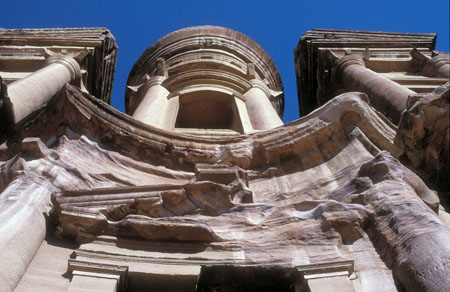A key requirement for photographing ruins is to place them in their correct context. To this end it is essential to understand at least the basic history of the structures, including when they were built, by whom and for what purpose. Only then is it possible to decide how to portray the ruins in a manner that hints at their history.

The surrounding landscape may offer a starting point for this process. The use of a wide-angle lens helps to place the ruins in the context of their surroundings although this may not always be an appropriate approach. When photographing Machu Picchu, the Inca ruins in Peru, it is clearly important to show the dramatic location of the site perched high on a ridge between to peaks. However, showing the A30 road running past Stonehenge in the Uk, or modern buildings of Cairo encroaching on the Pyramids of Egypt, might be less appropriate unless the photographer is seeking contrasts.
Always remember that ruins are abandoned structures and sites whose histories tell of lost cultures or stories from the past. Historic sites are natural storytellers if only the photographer is sufficiently attuned. Retelling something of the relevant story should consequently be high on the list of objectives.
 When photographing an abandoned institutional or industrial site, it is important to link the buildings or structures with their active past. If the site was a hospital look for a link with the medical world, and if it was once a place where cars were manufactured then use something relevant to make a connection. Try to place in the mind of viewers the feeling of the place. With a little imagination it should ideally be possible for them to see the hospital nurses or the new cars coming of the production line. It is not easy, but it is nevertheless possible.
When photographing an abandoned institutional or industrial site, it is important to link the buildings or structures with their active past. If the site was a hospital look for a link with the medical world, and if it was once a place where cars were manufactured then use something relevant to make a connection. Try to place in the mind of viewers the feeling of the place. With a little imagination it should ideally be possible for them to see the hospital nurses or the new cars coming of the production line. It is not easy, but it is nevertheless possible.
Wide-angle shots of a site, or at least a large part of it, can sometimes be framed by working through a doorway or window. This creates a foreground and consequent depth in the image, and gives the viewer an anchor or reference point from which they can relate to the layout of the whole site. In the image on the left, which shows the interior of an abandoned house in the gold-rush town of Kolmanskop in Namibia, it is immediately apparent that the desert surrounding the building is gradually reclaiming the area. The door frame in the foreground adds depth and reveals to viewers that they are seeing what was once a normal domestic interior.






